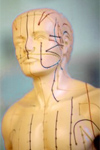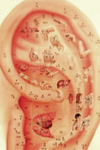|
Acupuncture is an important part of the Traditional Chinese Medicine (TCM), which was founded about 5000 years ago in China. The following introduction in this very effectful therapeutic method should be only a short insight for you, to get a feeling of how this it can act against pain. Following the apprenticeship of the chinese founders, energy is flowing in every body. this energy is concentrated in 12 main meridians and 2 midline meridians. If we are healthy there is a good balance of energy between the meridians - if the energetic flow is disturbed between outer and inner, upper and lower, right and left meridians, it causes a well defined pathological pattern and we get ill or painful.
Further more there are correlations between the skin and inner organs. Chinese medicine differenciates between Yang- and Yin meridians. Yang means male, sun, external, Yin means female, moon, internal...
As Acupuncture belongs to the so named "reflextherapies", it has the potential to improve or heal functional disorders. If the pathology has led zu structural damage, it can't relevantly influence the basic cause of pain. From some very good studies respectively basic science work we know that the main mechanism (except the chinese energy-model) for the effectivity of acupuncture are the marked vasodilatation, that means a reflectory induced increase of deep bloodflow and the relaxing effect on muscles.
How does Dr. Stengg use this method? He integrates acupunctur in a multimodal combination therapy. But he uses it also in structural damage like osteoporotic pain or the inflammed, compressed lumbar nerveroot after a strong discprolaps - but it must be clear: is it the method of choice with healing competence or is it a supporting, therapeutic tool (like in the discprolaps). Each physician should take the responsibility, to inform the patient, in which a.m. groups he belongs.
But as a therapeutic adjunct without sideeffects, it is a very effective complement in every modern, polymodal therapeutic concept, in particular in the field of complaints out of the locomotor apparatus. |

 |

